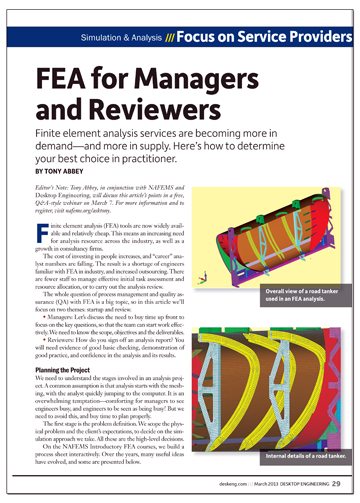Latest News
March 1, 2013
DE‘s contributing editor Tony Abbey, a recognized finite element analysis (FEA) trainer in NAFEM‘s classrooms and online courses, is planning to field your questions in a webinar titled “FEA for Managers & Reviewers: Ask Tony” (March 7).
So I took advantage of our editorial affiliation to toss him a question that’s been on my mind: How would you distinguish the terms “simulation” and “analysis”? Are they synonymous?
Tony replied:
There are no rules really in the definitions. I tend to think simulation is a broader term meaning overall representation of a real physical system with an equivalent approximation. That can range from a simple hand calculation or spreadsheet to a complex approach using one or more computer-based analyses using CAE software.
I think of an analysis as a single run of a specific model using the CAE software. So the simulation may consist of one analysis, but could embrace many. It is sometimes helpful to think of the simulation as an analysis-based project. This gets over the message that we might need to use a range of different types of analysis models at different stages of the simulation, or to investigate different aspects [of a design].
In his latest article “FEA for Managers and Reviewers” (the basis for his upcoming webinar), Tony cautioned against the Single Model Syndrome. He wrote, “Several models can be used to support different aspects of the project, such as an assembly global model, and local models of important details with finer mesh or plane strain 2D simplification. Many analysts build a single model, but we don’t need to be thus constrained.”
In the same article, he shared one of his tricks: He uses what he calls an under-the-table model. What did he mean by that? He replied, “In a nutshell it is a safety measure. If the main project model is complex and detailed, there is a chance it won’t be finished in time. To reduce the risk of having no answers, a simpler model which gives a more basic but useful representation is useful. Ideally it should be planned in as part of a stepping-stone approach, but often there is no official mandate for this; hence the terminology. This approach has kept me out of trouble on a fair number of projects.”
To register for Tony’s upcoming webinar, go to NAFEM’s event page here.
You can find out more about Tony’s e-learning courses at the links below:
Subscribe to our FREE magazine, FREE email newsletters or both!
Latest News
About the Author
Kenneth Wong is Digital Engineering’s resident blogger and senior editor. Email him at [email protected] or share your thoughts on this article at digitaleng.news/facebook.
Follow DE






